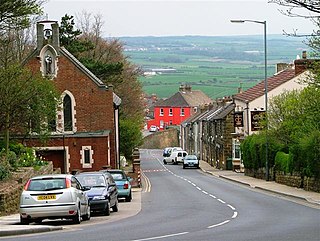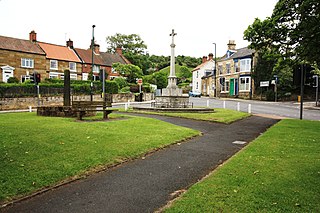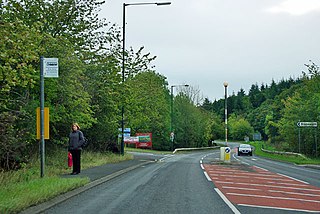
North Yorkshire is a ceremonial county in the Yorkshire and the Humber and North East regions of England. It borders County Durham to the north, the North Sea to the east, the East Riding of Yorkshire to the south-east, South Yorkshire to the south, West Yorkshire to the south-west, and Cumbria and Lancashire to the west. Northallerton is the county town.

Cleveland is a land of hills and dales from the River Tees to Vale of Pickering, England. The name means "cliff-land".

Eston is a former industrial town in the Redcar and Cleveland unitary area of North Yorkshire, England. The local authority ward covering the area had a population of 7,005 at the 2011 census. It is part of Greater Eston, which includes the outlying settlements of Grangetown, Normanby, South Bank, Teesville and part of Ormesby.

The North Riding of Yorkshire was a subdivision of Yorkshire, England, alongside York, the East Riding and West Riding. The riding's highest point was at Mickle Fell at 2,585 ft (788 m).

Redcar and Cleveland is a local government district with borough status in the ceremonial county of North Yorkshire, England. Its council has been a unitary authority since 1996, being a district council which also performs the functions of a county council.

The Esk Valley Line is a railway line located in the north of England, covering a total distance of approximately 35 miles (56 km), running from Middlesbrough to Whitby. The line follows the course of the River Esk for much of its eastern half.

Brotton is a village in the civil parish of Skelton and Brotton, in the Redcar and Cleveland district, in the ceremonial county of North Yorkshire, England It is situated approximately 2.5 miles (4 km) south-east of Saltburn-by-the-Sea, 9 miles from Redcar, 12 miles (19 km) east of Middlesbrough and 14 miles (23 km) north-west of Whitby.

Easington is a village in the civil parish of Loftus, in the Redcar and Cleveland district, in the ceremonial county of North Yorkshire, England and is part of the North York Moors National Park. The village is situated on the A174 road, 1 mile (1.6 km) east of Loftus, 8 miles (13 km) east of Guisborough, and 10 miles (16 km) north-west of Whitby. At the 2011 census, the village had a population of 923.

Moorsholm is a village in the civil parish of Lockwood, in the unitary authority area of Redcar and Cleveland and the ceremonial county of North Yorkshire, England.

Skelton-in-Cleveland or Skelton is a market town in the civil parish of Skelton and Brotton at the foot of the Cleveland Hills and about 10 miles (16 km) east of Middlesbrough centre. It is in the borough of Redcar and Cleveland, North Yorkshire, England.

The Cleveland Hills are a range of hills on the north-west edge of the North York Moors in North Yorkshire, England, overlooking Cleveland and Teesside. They lie entirely within the boundaries of the North York Moors National Park. Part of the 110-mile (177 km) long Cleveland Way National Trail runs along the hills, and they are also crossed by a section of Wainwright's Coast to Coast Walk. The hills, which rise abruptly from the flat Tees Valley to the north, include distinctive landmarks such as the cone-shaped peak of Roseberry Topping, near the village of Great Ayton – childhood home of Captain James Cook.

Stainsacre is a village in the civil parish of Hawsker-cum-Stainsacre in the Scarborough district of North Yorkshire on the edge of the North York Moors National Park. It lies 2 miles (3.2 km) south-east of Whitby, near the A171 road.

Eston Nab is a rocky outcrop hill in the town of Eston, Redcar and Cleveland, North Yorkshire, England.

Carlton Bank is a hill in the Cleveland Hills, in north-east England. It is within Carlton Moor in the North York Moors and overlooks the villages of Carlton-in-Cleveland and Faceby. The summit provides extensive views of Teesside including Middlesbrough and Redcar to the north as well as the surrounding moorland. Roseberry Topping can also be clearly seen from the summit in a north-easterly direction. The bank was host to an alum works in the 18th century.
Donald Burluraux is an English former footballer who scored 12 goals from 120 appearances in the Football League playing as a winger for Middlesbrough, York City and Darlington in the 1970s. He went on to play non-League football for Whitby Town.

Scaling Dam Reservoir is a freshwater man-made lake on the edge of the A171 road in North Yorkshire, England. The reservoir is near to the hamlet of Scaling Dam from where it derives its name, and was built in 1958.
Roseberry Parkway railway station is a proposed railway station which would be between Nunthorpe and Great Ayton railway stations on the Esk Valley Line, in North Yorkshire, England. The station was proposed in August 2019 by a joint project between Redcar & Cleveland and Middlesbrough Councils and the Tees Valley Combined Authority. The project is "aimed at easing road congestion and improving access to East Cleveland".

Kettleness, is a hamlet in the Scarborough District of North Yorkshire, England. The settlement only consists of half-a-dozen houses, but up until the early 19th century, it was a much larger village. However, most of that village, which was on the headland, slipped into the sea as a result of instability caused by quarrying for the alum industry. Kettleness became a smaller settlement, with houses rebuilt slightly further inland.

Hutton Village is a settlement in the Hutton Lowcross area of Guisborough in North Yorkshire, England. Whilst the area itself is mentioned in the Domesday Book, the village was built largely due to the development of the ironstone industry in the Cleveland Hills. The name Hutton Lowcross referred to the township in the area, whereas the settlement is now known as Hutton Village. The village is set in a narrow dale that carries Hutton Beck northwards towards Guisborough.

Slapewath is a hamlet in the borough of Redcar and Cleveland and the ceremonial county of North Yorkshire, England. Whilst the name of the hamlet is recorded as far back as the 13th century, it was developed due to the alum and ironstone industries of the North-Eastern part of Yorkshire in the 16th and 19th centuries respectively. The hamlet lies on the A171 road.


















